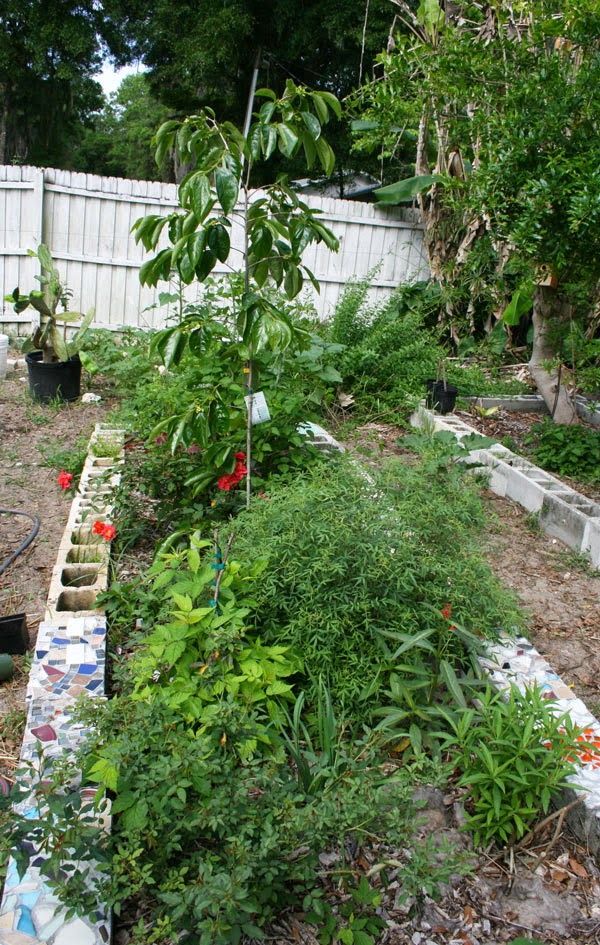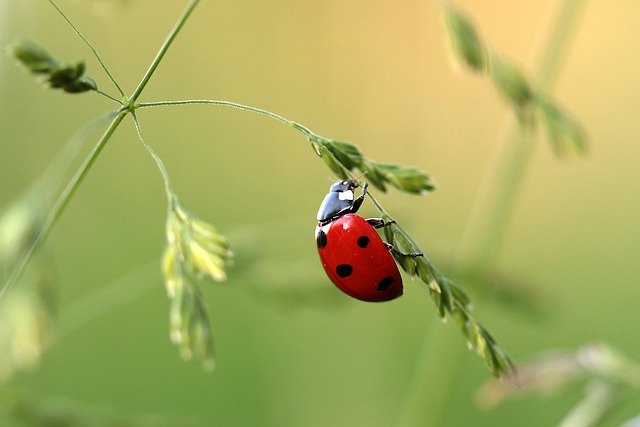Most of us have this idea of how gardens are supposed to look.
Everything needs to be kept in boundaries, arranged in rows, and kept free of dead plants, sticks, debris piles, etc.
Yet keeping things neat is great in the kitchen, at the office, or in the workshop—but it isn’t helping your garden. Sure, it might look nice and utilitarian, but functionality usually goes deeper than surface appearances.
Nature is a mess—a raucous, deliberate, incredible, outrageous mess. If you let some of that mess into your garden, your plants will benefit.
Mess Creates Habitat

A perennial garden bed my daughter and I planted near my annual beds.
Everyone knows that ladybugs are the good guys.
Or gals.
Or whatever sex they are. I can’t tell.
Anyway, we want them in our gardens. They devour aphids and delight children. Both are great reasons to keep them around. Yet when we rip out a bed of spent tomatoes or chop down the rest of the season’s collards, what happens to the ladybugs? They fly off in search of greener pastures.
That’s not to say you should leave tons of rotting vegetable plants everywhere, it just means you should think twice before you clear everything from your beds. I deliberately leave patches of weeds here and there around my yard and gardens for beneficial insects to live in.
You May Also Enjoy:
Also, though it sounds counterintuitive, you want places for aphids to live, as well.
Having some aphids around draws in the ladybugs and increases their population. By letting patches of plants sit, you create habitats—and ladybugs aren’t the only creatures that will benefit.
You’ll also create space for praying mantises, lacewings, wheelbugs, lizards, frogs, toads, centipedes, spiders, worms, and pollinators like moths, butterflies, bees, and wasps.
Beyond leaving weeds and spent plants around, you can also add rock piles, logs, stacks of sticks, and water sources to your gardens.
I tend to plant mixed beds of perennial plants near my annuals, which provides year-round living habitat (except in the very coldest months).
Mess Confuses Pests
Let’s pretend we’re at the Golden Corral. For those of you who don’t know, the Golden Corral is an all-you-can-eat buffet filled with a large variety of dishes and frequented by lots of overweight people who are one insulin shot or cardiac event away from death. It’s an incredibly easy way to stuff yourself on a budget. You can load up your plate with mashed potatoes, hot dogs, tater tots, lasagna, margarine-slathered mushrooms, chocolate cake, and pizza, then slather the whole thing in gravy and soft-serve ice cream.
No one cares! It’s fun!
Now imagine you went to the Golden Corral and found that the buffet had changed. Instead of a massive array of delicious sub-par food, the food was scattered here and there and between the foods were a variety of disgusting and poisonous things.
Sure enough, there are the mashed potatoes… but they’re in between a platter of dirty socks and a bucket of Lysol. Further down, you might find the margarine-slathered mushrooms, but they’re uncomfortably close to a pile of stable manure and a big bowl of tung oil.
If you were starving, you might stick around—but you’d have to admit, the dining experience would be really unsatisfying and would likely push you right out the door and across the street to Waffle House.
That’s what your garden looks like to pests when you mix things up. The Golden Corral of Death.
Many pests are host-specific, which means they only like to eat certain plants. Mix up the menu with plants they can’t eat—or ones that might even be toxic to them—and your garden goes from being a bug buffet to an outlet condemned by the Arthropod Health Department.
Herbs, flowers, beans, greens, climbers, creepers, and shrubs all have their place in a home garden: mix them up and you’ll mix up the pests, too.
Mess Is Good for the Soil
It’s true!
Just like I wrote in my article on sheet-mulch gardening, organic matter is a boon to poor soil—but what we sometimes don’t realize is how many miles of roots extend beneath the surface of our gardens. When a plant dies and rots in place, the roots become compost in the soil. When leaves fall, their nutrients return to the earth. One of the stupidest things modern gardeners do is clean up all their leaves and toss or burn them. DON’T DO THAT! Those leaves are packed with fertility—chucking them is like throwing away fertilizer.
Just don’t do it.
In your garden beds, letting leaves fall and rot is a good thing. In fact, you can trench your kitchen scraps right into your garden beds and feed the earth that way. I’ve buried paper plates, slaughter wastes, rotten food, and other organic matter into fallow beds where it attracts and feeds worms while enriching the soil and providing a boost for the plants that come later.
Another “mess” that’s good for the soil: weeds! It’s good to let some greenery cover the ground, even if it’s not anything you can eat (though some weeds are delicious).
Obviously, you don’t want to let pigweed or other noxious plants go to seed in your garden beds; but you don’t have to be a stickler about keeping the soil bare between plantings. At the very least, toss some cover crop seed down on areas you’re not using.
You May Also Enjoy:
I like to mix rye grass, mustard, chickpeas, fava beans, lentils, collards, and other seeds from tough plants together and rake them into empty beds. I’m not looking for a harvest; I’m looking to keep life in the soil and protect the ground from leaching, baking in the sun, and erosion. Plus, you can pick and eat what you like, and when you’re ready to plant that bed again, you have green manure you can turn under, or fodder for the compost pile.
Making a mess might rankle some of us—particularly those of us on the neatnik side of the spectrum—but it’s a great way to invite in the good guys, bother the bad guys, and keep the soil healthy.
Sometimes it’s okay to put down the hoe, relax, and let things go a bit.
You’ll be fine—nature’s got your back.
David The Good is a Grow Network Change Maker, a gardening expert, and the author of five books you can find on Amazon: Compost Everything: The Good Guide to Extreme Composting, Grow or Die: The Good Guide to Survival Gardening, Totally Crazy Easy Florida Gardening, Create Your Own Florida Food Forest, and Push the Zone: The Good Guide to Growing Tropical Plants Beyond the Tropics. Find fresh gardening inspiration at his website TheSurvivalGardener.com and be sure to follow his popular YouTube channel.








COMMENTS(4)
Mess? Hmm. Yeah, I think I can handle that.
these are great ideas and concepts! In Hawaii we don’t want the earth uncovered or a rampant invasion of unwanted plants AND pests comes. We also don’t want mess as it encourages molds and unwanted pests too.
I’ll add a few of these ideas to my “chop and drop” activities. I like the idea of keeping as many beneficial insects and creatures aroung as possible. I’m always concerned about my impact on the forest I share with nature (literally).
ah david the good is found sharing here…nice find manythxs